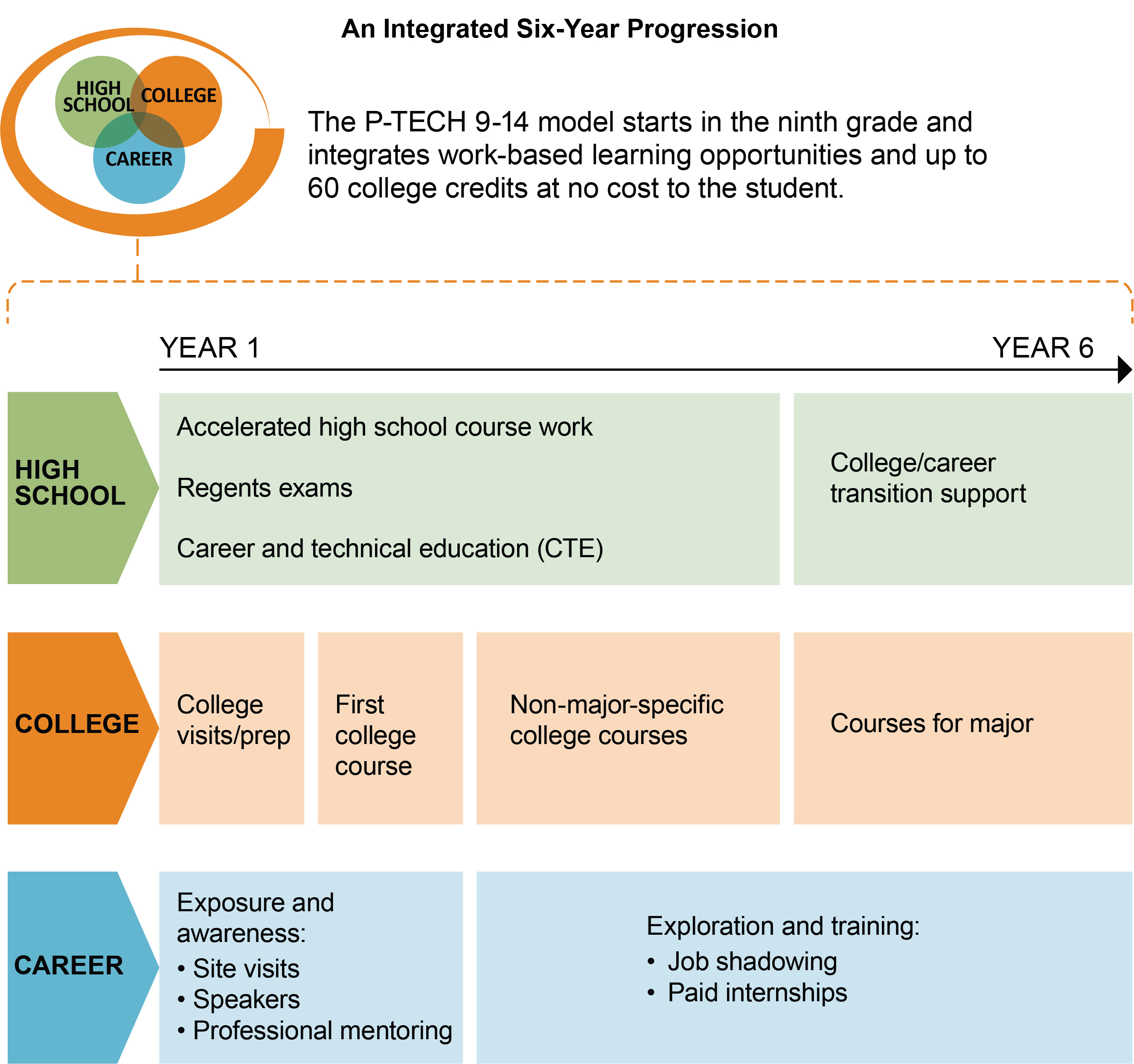New Promising Evidence for New York City's P-TECH 9–14 Schools
New Promising Evidence for New York City's P-TECH 9–14 Schools
The network research team at MDRC is conducting the first rigorous evaluation of the New York City P‑TECH Grades 9–14 model, which connects high schools, local community colleges, and employers to help students bridge the school-to-work divide. Initial findings suggest students are achieving desired benchmarks, including earning more total credits and career and technical education (CTE) credits than comparison students after three years of high school. Read on for more key findings from two of the report authors: Rachel Rosen, Ph.D., and Crystal Byndloss, Ph.D., of MDRC. Then read the report and listen to a podcast to learn more.
The route to high-wage jobs in science, technology, engineering, and math (STEM) fields can be difficult to navigate for many students, particularly those who have attended schools in low-income communities. The New York City (NYC) P‑TECH Grades 9–14 model is an innovative approach that aims to seamlessly connect high school, postsecondary education, and workforce training to help students attain their career goals.
Since the first P‑TECH 9–14 school opened in 2011, the model has proliferated rapidly, with more than 200 schools now operating worldwide. To provide the first rigorous evidence of the model’s impact, MDRC is conducting an evaluation of the original seven NYC P‑TECH schools. A report of the initial results provides encouraging news as to how well these schools are serving students, most of whom are Black and Hispanic, come from lower income neighborhoods, and entered high school academically underprepared.
The report, released in May 2020, focuses on how P‑TECH students in the first three years of high school are performing on key education benchmarks. In addition, the report provides background on the development of the P‑TECH 9–14 model; its high school, college, and work-based learning components; and some of the ways in which the schools in the study vary in their implementation of the model.
About the P-TECH 9–14 schools in the study
The seven P‑TECH 9–14 schools that MDRC is evaluating represent a unique collaboration between the NYC Department of Education, the City University of New York (CUNY), and industry employers. In the six-year schools, P‑TECH students earn a high school diploma and an applied associate degree in a science, technology, engineering, or mathematics (STEM) field. In addition, students participate in valuable work-based learning opportunities provided by one or more industry partners.
The associate degrees offered by each school relate directly to the school’s industry partners. For example, the first P‑TECH 9–14 school, located in Brooklyn, partners with IBM and offers associate degree pathways in two areas related to technology: computer systems technology and electromechanical engineering technology. Another P‑TECH 9–14 school, which partners with Consolidated Edison, an energy utility, offers associate degrees in energy engineering.

Interim implementation and impact findings
Early results from MDRC’s evaluation include several findings about how the P‑TECH 9–14 schools are implementing the model. All seven schools accelerate high school course work as well as when students take the New York State High School Regents exams. The accelerated high school classes mean that students have the opportunity to begin dual-enrollment in college course work as early as 10th grade, although the pacing of courses varies by student.
In addition, all seven schools provide CTE courses as part of the core requirements. The high school and early college CTE course work complement one another to create seamless pathways that lead to credentials in specific fields. All seven schools also offer work-based learning opportunities, including mentoring, job-shadowing, and internship experiences; however, the level of access to these opportunities varied across schools and students.
The evaluation’s impact study used the NYC high school admissions lottery process to create comparable groups of students, some of whom won the opportunity to attend a P‑TECH 9–14 school (program group), and some of whom were placed in other high schools across the city (comparison group). Initial findings indicate that P‑TECH 9–14 students earned more total credits than comparison students, with the results driven by credit accumulation in CTE and other nonacademic subjects. Moreover, these additional credits did not appear to come at the expense of earning academic credits.
In addition, at the end of two years of high school, almost twice as many P‑TECH 9–14 students as comparison students had passed the English Language Arts (ELA) Regents exam with a score qualifying them for enrollment in CUNY courses. After three years of high school, this gap had narrowed but still favored the P‑TECH 9–14 students. The ELA pass rates indicate that more P‑TECH 9–14 students were eligible to dual enroll in CUNY course work earlier in high school than their comparison group counterparts.
These early findings provide promising evidence about how well the P‑TECH 9–14 model supports student success. Look for our final report coming out in 2022.
Interested in learning more? Listen to a podcast or read a transcript featuring researcher Rachel Rosen, Ph.D., the lead report author, discussing the early findings and their implications.
